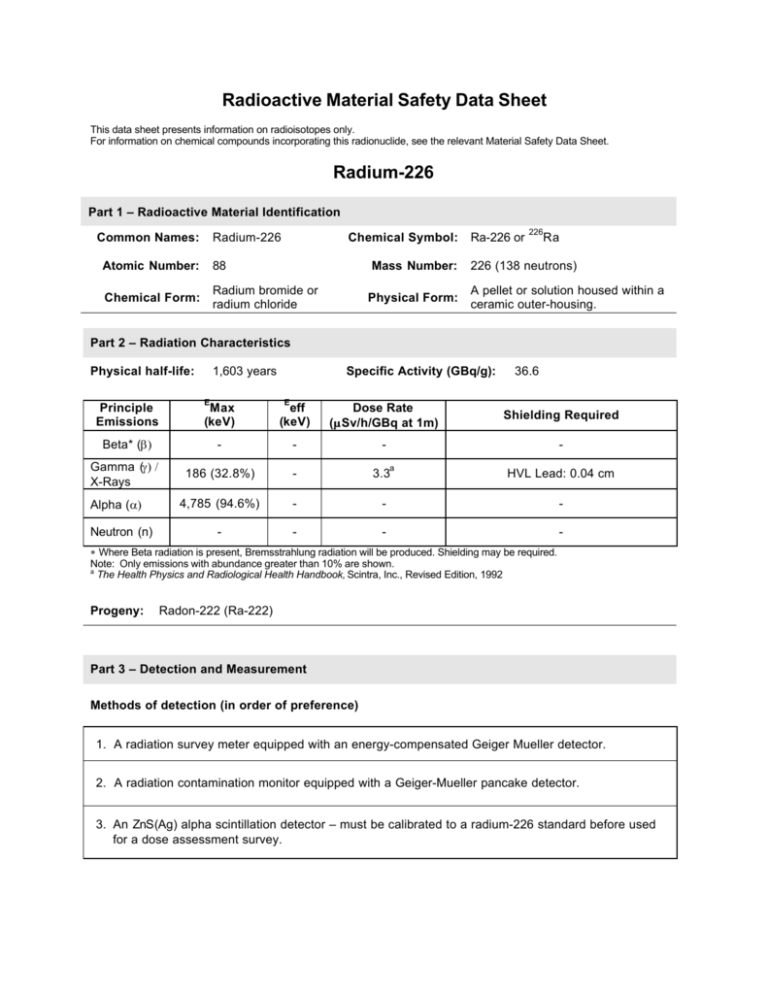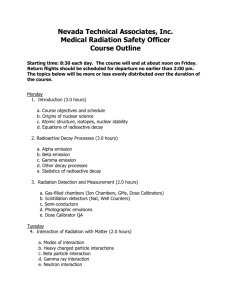Radium-226 Safety Data Sheet: Radiation & Handling
advertisement

Radioactive Material Safety Data Sheet This data sheet presents information on radioisotopes only. For information on chemical compounds incorporating this radionuclide, see the relevant Material Safety Data Sheet. Radium-226 Part 1 – Radioactive Material Identification Common Names: Radium-226 Chemical Symbol: Atomic Number: 88 Mass Number: Chemical Form: Radium bromide or radium chloride Physical Form: Ra-226 or 226 Ra 226 (138 neutrons) A pellet or solution housed within a ceramic outer-housing. Part 2 – Radiation Characteristics Physical half-life: Principle Emissions 1,603 years E Specific Activity (GBq/g): E 36.6 Max (keV) eff (keV) Dose Rate (µ µ Sv/h/GBq at 1m) Shielding Required Beta* (β) - - - - Gamma (γ) / X-Rays 186 (32.8%) - 3.3 HVL Lead: 0.04 cm 4,785 (94.6%) - - - - - - - Alpha (α) Neutron (n) a ∗ Where Beta radiation is present, Bremsstrahlung radiation will be produced. Shielding may be required. Note: Only emissions with abundance greater than 10% are shown. a The Health Physics and Radiological Health Handbook, Scintra, Inc., Revised Edition, 1992 Progeny: Radon-222 (Ra-222) Part 3 – Detection and Measurement Methods of detection (in order of preference) 1. A radiation survey meter equipped with an energy-compensated Geiger Mueller detector. 2. A radiation contamination monitor equipped with a Geiger-Mueller pancake detector. 3. An ZnS(Ag) alpha scintillation detector – must be calibrated to a radium-226 standard before used for a dose assessment survey. Dosimetry Whole Body þ Skin ¨ Extremity ¨ Neutron ¨ Internal: Sealed sources pose no internal radiation hazard. However, in the event of loss of containment by the sealed source, all precautions should be taken to prevent inhalation or ingestion of the material. Critical Organ(s): Bone tissue Annual dose limits: Non-nuclear energy workers: Nuclear energy workers: 1mSv per year a) 50 mSv in one year b) 100 mSv total over five years Pregnant nuclear energy workers: 4 mSv over the balance of the pregnancy Part 4 – Preventive Measures Always use the principles of time, distance and shielding to minimize dose Engineering Controls: Sealed radioactive sources used in industrial applications should always be within a protective source housing to minimize radiation dose and to protect the source capsule from damage. Personal Protective Equipment (for normal handling of unsealed sources only. Always wear disposable gloves, safety glasses, personal protective equipment and clothing as appropriate to the material handled). No special PPE required. Special Storage Requirements: None Part 5 – Control Levels Oral Ingestion Inhalation ALI (kBq) ALI (kBq) DAC (Bq/ml) 74 22.2 1.11 x 10 Exemption Quantity (EQ): 10,000 Bq Part 6 – Non-Radiological Hazards None identified at this time. OSHA Permissible Exposure Limit (PEL) No limit set at this time -5 Part 7 - Emergency Procedures The following is a guide for first responders. The following actions, including remediation, should be carried out by qualified individuals. In cases where life-threatening injury has resulted, first treat the injury, second deal with personal decontamination. Personal Decontamination Techniques • • • Wash well with soap and water and monitor skin Do not abrade skin, only blot dry Decontamination of clothing and surfaces are covered under operating and emergency procedures Spill and Leak Control • • • • Alert everyone in the area Confine the problem or emergency (includes the use of absorbent material) Clear area Summon Aid Damage to Sealed Radioactive Source Holder • • • • Evacuate the immediate vicinity around the source holder Place a barrier at a safe distance from the source holder (min. 5 meters) Identify area as a radiation hazard Contact emergency number posted on local warning sign Suggested Emergency Protective Equipment • • • • Gloves Footwear Covers Safety Glasses Outer layer or easily removed protective clothing (as situation requires) Revision Date: December 17, 2001 This information was prepared by: Stuart Hunt & Associates Ltd. 20 Rayborn Crescent St. Albert, Alberta T8N 5C1 Phone: (780) 458-0291 or (800) 661-4591 Fax: (780) 459-0746 Web site: www.stuarthunt.com











